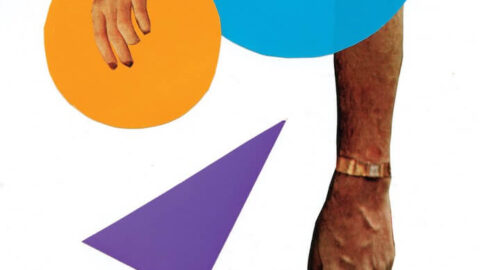Bearthoven’s Trios (Cantaloupe Music) is an imaginative and aesthetically well-defined debut album brought to life by Matt Evans (percussion), Karl Larson (piano), and Pat Swoboda (bass). Bearthoven’s percussion, piano, and bass instrumentation, often seen in jazz settings, is virtually unheard of in the contemporary classical domain. The richness of these pieces demonstrates that this instrumentation isn’t a cheap gimmick, but an opportunity for a fresh contribution to the contemporary classical landscape. These tracks alternate between hard-grooving, post-minimal adrenaline sprees, and expansive and blossoming timbre-centric slow jams by composers Brooks Frederickson, Anthony Vine, Ken Thomson, Fjóla Evans, Brendon Randall-Myers, and Adrian Knight.
The album kicks off with the high-energy Undertoad by Brooks Frederickson. It begins with long strings of repeated sounds–the strumming of a bass string, staccato chords on the piano, and the tapping of a high hat. These machine-like sounds resemble a kind of hushed clockwork, but where each instrument is following a different beat. As these sounds drift in and out of sync, distending and orbiting, they come to resemble the interwoven fibers of a thread, or taffy being stretched. The blurring tempi between the instruments creates an irresistible forward-motion, which is later punctuated by percussive interruptions and cascading bass lines, in turn sending the piano ricocheting into new tempi once again. Near the end of the piece, the chains of repeated notes return, this time intensifying and swelling before dissipating into receding echoes. Frederickson shows a mastery of pacing and dramatic tension, as Undertoad introduces new elements at just the right moments, without growing stale.

In sharp contrast to the relentless and grooving first track, Anthony Vine’s From A Forest of Standing Mirrors begins with an expansive and haunting texture of sustained vibraphone pitches, high-pitched bass harmonics, and muted and resonant sounds from the piano. As the piece develops, sharp hits from the percussion and piano tear into this delicate soundscape, contributing to the growing din. When the soundscape becomes so chaotic that it threatens to burst, a monastic humming coupled with high-pitched bass harmonics emerges and an uneasy bliss takes over. Unlike Frederickson’s groove-centric piece, it is the tension between the activity and inactivity of unmetered events that drives Vine’s piece forward. His use of extended piano techniques and a wide variety of percussion instruments creates a decadent sonic environment. The ensemble’s keen attention to the evolving color and timbre makes this piece compelling and dream-like.
With Shoaling, Fjóla Evans creates a vivid and layered sound world saturated with nautical imagery. In the composer’s words, shoaling can refer to a group of fish moving together yet following their own paths—and that sense of individuality within the group is what permeates this piece. Evans creates an evocative and immersive sound world that begins with a deep and resonant moan on the drums and bass, which resembles the call of a distant foghorn. This call is repeated several times, growing and fading away like the ebb and flow of the ocean. Each wave of sound adds layers of timbral complexity, growing and filling space like an incoming tide. Halfway through the track, the rumbling ocean of sound gives way, revealing a trace consonant harmony that lingers, suspended. After this brief moment of stasis, the music quickly turns more active, with a chugging bass part, arpeggiated material on the piano, and shimmering and splashy percussion. A darkness grows as the harmonic material turns dissonant and menacing, carrying through to the end of the piece.

Brendon Randall-Myers’ Simple Machine begins with a heavy, head-banging beat. The punk/metal vibe that permeates this track is emphasized by the use of electric bass, drum kit, and a synthesized, distorted beat. What starts out as a straightforward, punchy rhythm quickly develops into something more intricate and dynamic, brimming with syncopated escapades and polyrhythmic palpitations. Larson’s athletic pianism stands out here, and his energetic and daring playing gives Simple Machine that bite it needs. As the piece continues on, the rhythmic excursions get longer and more complex. We lose sight of the original meter and beat, as if swept up by a whirlwind. In the last few minutes of the piece, the complex rhythms settle and it returns to the original hard groove, this time with catchy harmonic material. The music eventually reaches its breaking point and bursts, leaving behind a pointillistic trail of material over the still-driving distorted beat. Randall-Myers draws inspiration from long-distance running and extreme metal and punk shows, in which transcendental moments arise out of “individually meaningless, physically uncomfortable actions.” Truly by the end of Simple Machine we have crossed over from the mundane to the sublime, and like a good run, it leaves us with a feeling of elation.
Trios showcases diverse and masterful playing from Evans, Larson, and Swoboda. The players interlock complex rhythmic material with the precision of a surgical team, so that even in the most chaotic whirlwind of fragmented material everything remains crystal clear. Equally impressive is the group’s attention to composite sound in pieces that focus more on evolving timbre, where the trio masterfully conveys subtle and delicate shifts in color. With its hypnotic grooves and richly evolving soundscapes, Trios is an aesthetically unified offering, and a pleasure to listen to.
























